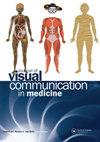Person-centered care, dementia and graphic medicine.
IF 0.7
Q4 RADIOLOGY, NUCLEAR MEDICINE & MEDICAL IMAGING
Journal of Visual Communication in Medicine
Pub Date : 2022-10-01
Epub Date: 2022-07-22
DOI:10.1080/17453054.2022.2097060
引用次数: 0
Abstract
Abstract Dementia is currently promoted as an ‘epidemic.’ Such a figuration not only impacts the afflicted person but also affects caregiving practices. While the medical model solely delves into the histopathological study of dementia, recent research observes that person-centered care practices provide new ways of paying attention to the dementia-afflicted individuals. Graphic medicine is one such site which intervenes and rewrites the dominant narratives of dementia which treat dementia in terms of loss and care burden. Taking these cues, through a close reading of Valérie Villieu and Raphaël Sarfati’s graphic narrative Little Josephine: Memory in Pieces (2020), the present article attempts to investigate cultural alternatives to the demonising figurations of dementia and dementia-related care practices. In so doing, the article not only establishes the increasing role of graphic medicine as a revisionary tool/as a movement but also, through close reading Little Josephine: Memory in Pieces (2020), humanises and reverses dementia care as a ‘burden’.以人为本的护理,痴呆症和图形医学。
痴呆症目前被宣传为一种“流行病”。这样的形象不仅影响了受折磨的人,也影响了护理实践。虽然医学模型只研究痴呆症的组织病理学研究,但最近的研究发现,以人为本的护理实践提供了关注痴呆症患者的新方法。图形医学就是这样一个网站,它介入并重写了痴呆症的主要叙述,从损失和护理负担方面治疗痴呆症。根据这些线索,通过仔细阅读valsamrie Villieu和Raphaël Sarfati的图形叙事《小约瑟芬:碎片的记忆》(2020),本文试图研究痴呆症妖魔化形象和痴呆症相关护理实践的文化替代方案。通过这样做,这篇文章不仅确立了图形医学作为一种修订工具/作为一种运动的日益重要的作用,而且通过仔细阅读《小约瑟芬:碎片记忆》(2020),将痴呆症护理人性化并将其扭转为一种“负担”。
本文章由计算机程序翻译,如有差异,请以英文原文为准。
求助全文
约1分钟内获得全文
求助全文
来源期刊

Journal of Visual Communication in Medicine
RADIOLOGY, NUCLEAR MEDICINE & MEDICAL IMAGING-
CiteScore
1.50
自引率
14.30%
发文量
34
期刊介绍:
The Journal is a quarterly, international, peer-reviewed journal that acts as a vehicle for the interchange of information and ideas in the production, manipulation, storage and transport of images for medical education, records and research.
 求助内容:
求助内容: 应助结果提醒方式:
应助结果提醒方式:


